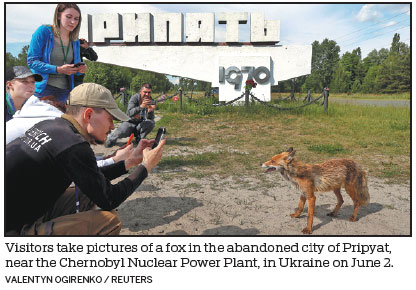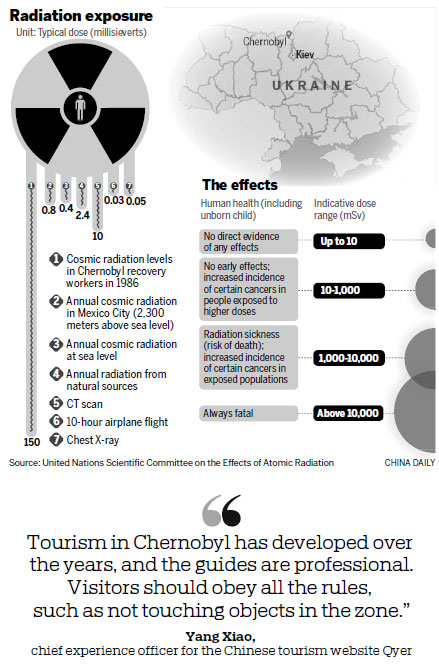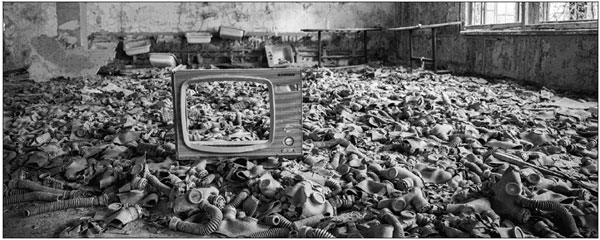DESPITE RISKS, CHINESE VISITORS HEAD TO CHERNOBYL
Nuclear disaster site a popular 'dark tourism' area
After Li Yimeng took a one-day trip to Chernobyl in Ukraine, she washed her shoes five times, cleaning away any radiation that may have been on the soles.
She also washed her clothes, backpack and even the magnets she bought in the area, scene of the Chernobyl disaster - the world's biggest nuclear power plant accident - which occurred on April 26, 1986.
Since the abandoned area was opened to tourists in 2011, there has been an increasing number of visitors, but risks from radiation remain.
"The sudden fear I experienced after the trip was purely psychological, but I didn't feel ill," said Li, a photographer from Beijing, who traveled to Ukraine in October.
When the disaster occurred, parts of the then Soviet Union, including Ukraine, Belarus and Russia, were exposed to substantial amounts of radiation, with the aftereffects in the following years including increased cases of thyroid cancer. The Soviet Union broke up in 1991, five years after the accident.
Tourists can book a guided, one-day tour of the area through travel agencies in Kiev, the capital of Ukraine.
Local travel agencies claim that as radioactivity levels fall over time, and with cleanup operations being conducted at Chernobyl, short visits on designated routes are safe, but tourists must follow radiation safety regulations.
Some travel agencies state on their websites that the total amount of radiation a person is exposed to during a 10-hour trip to the area is several times lower than the level experienced during a transatlantic flight.
However, the potential risk is still there, as the dangerous nuclear waste is sealed in a "tomb".
Immediately after the meltdown in 1986, a massive steel and concrete structure, known as "the sarcophagus", was hastily constructed to cover the damaged nuclear reactor number 4 at the Chernobyl Nuclear Power Plant. The installation was completed at the end of November that year.
By the end of 2016, Ukraine and other countries worked together to establish a giant shield to replace the sarcophagus to prevent further leaks of radioactivity. The shield is designed to secure the site for the next 100 years, and tourists can take photos of the area from a distance.
Chernobyl is one of the most popular areas for "dark tourism", which refers to traveling to places associated with death and tragedy.
After the hit TV miniseries Chernobyl aired on HBO in May, increasing numbers of tourists have been keen to visit the disaster area.
According to the Chicago Tribune, the Ukrainian government reported that nearly 72,000 visitors traveled to Chernobyl last year, up from 50,000 in 2017.
In July, the Ukrainian government said it would make Chernobyl an official tourist site, with plans to improve infrastructure, checkpoints, routes, waterways and radiation monitoring.
Worries faded
Although many visitors to Chernobyl are from Western countries, a few Chinese tourists interested in history or photography have traveled to the area.
Li booked her one-day trip, which cost $84, in advance online through a local travel agency. She also paid $10 for a Geiger counter.
Her destination was the Chernobyl Exclusion Zone, an area within a 30-kilometer radius of nuclear reactor number 4.
Once the journey started, most of her worries faded, and she became so immersed in the experience that she had no time to worry about the potential risks.
"I had a bird's-eye view from the top of a Soviet-style building. The autumn landscape was beautiful, tranquil and desolate, with derelict buildings surrounded by yellow-leafed trees. But this sudden exposure to the reality of Chernobyl made me want to know more about the area's history," Li said.
"As the world undergoes great changes, this place remains unchanged, as if time is at a standstill. The scene is imprinted on my memory."
Tourists to Chernobyl must wear long-sleeved clothing, full-length pants and shoes that cover the whole foot. They are warned not to touch any object in the zone or to sit on the ground.
On the minibus that took the tour group Li joined to the site, the guide showed a documentary about the disaster. Two of the 10-strong party were Chinese, and others came from European countries.
To enter the zone, visitors must show their passports and pass through a security check. They can have lunch in a canteen, with food transported from Kiev. When they are about to leave, they have to pass a body-scan test to check for high levels of radiation.
The ghost city
Pripyat was built as a model Soviet city to house workers at the Chernobyl Nuclear Power Plant and their families.
The most-photographed area of the city is the amusement park, which was scheduled to open on May 1, 1986, but all 50,000 citizens were evacuated just days before.
When the tour guide placed his Geiger counter close to a yellow Ferris wheel, the device indicated high levels of radiation.
Li said the radiation levels in the soil, fallen leaves and other items in the area were much higher than those found in the air.
The guide handed out old photos of different sites in the area so that the visitors could compare them with how they look now.
Scenes from Pripyat are used in some video games, enabling participants to explore the ghost city through virtual reality. One scene features the city's old swimming pool, showing a clock that has stopped on a wall.
Li also visited abandoned classrooms with scattered books and fallen desks, a room with numerous gas masks and a coffeehouse frequented by workers.
As she concentrated on taking photos, she suddenly found she had been left on her own, but as fear set in, she ran as fast as possible and was able to catch up with the rest of the group in a couple of minutes. However, they seemed the longest moments of her life to date.
"It was an unforgettable moment during the visit. I was afraid of being lost and having to spend the night there on my own. After that, I followed the tour guide closely," she said.
"On our way back to Kiev, we watched a documentary about the carefree lives of the people in Chernobyl before the disaster. I experienced a whole range of emotions as I saw the area where they used to live, which is now a wasteland," she said.
Li believes that as trips to Chernobyl become more popular, a limit may be placed on visitor numbers.
"It's not a place to seek novelty. Tourists should realize the potential risks before they make their plans," she said.
Li said the Chernobyl disaster is an important part of Ukraine's history. She suggested that those not planning to go to the exclusion zone visit the Ukrainian National Chernobyl Museum instead, which houses a wide collection of artifacts, media exhibits and scale models about the disaster.
Worldwide visits
Yang Xiao, chief experience officer for the Chinese tourism website Qyer, has traveled to popular dark tourism and urban exploration sites worldwide to take photos, including the abandoned Zeljava Air Base on the border between Croatia and Bosnia-Herzegovina.

The Chernobyl Exclusion Zone can be categorized as both dark tourism and urban exploration. In 2016, Yang booked a two-day tour to Chernobyl and stayed overnight near the zone in a basic hotel. As she took a stroll at night, she had to remain in a restricted area.
"In the world's most contaminated area, I had the most gorgeous view of the Milky Way. It was amazing," she said.
Yang added that she needed more time to take pictures, as she only had a fleeting glimpse of the exclusion zone.
She visited the hospital in Pripyat, where firefighters responding to the disaster were treated. "I felt very sad at the site," she said.
"Tourism in Chernobyl has developed over the years, and the guides are professional. Visitors should obey all the rules, such as not touching objects in the zone," she said.
Interest in the history
Zhang Ye, 30, who works at the Bro Adventures travel agency in Beijing, is impressed by the book Voices from Chernobyl: The Oral History of a Nuclear Disaster by the 2015 Nobel literature laureate Svetlana Alexievich.
The Belarusian author interviewed hundreds of people affected by the nuclear accident, ranging from members of the public and doctors to those who were called in to do clean-up work.
"I was greatly moved by the survivors' personal stories, including how their lives have been changed. When they were ordered to leave in a hurry, they thought that one day they would return home. But that day never came," Zhang said.
"These stories made me want to visit the place and see everything for myself."
Zhang, driven by his interest in the culture of the former Soviet Union, has visited 14 out of the 15 countries that were once part of it.
In Pripyat, he found traces of the hasty evacuation of residents, such as scattered personal items.
He was saddened by the sight of dirty children's beds and abandoned plastic dolls at a dilapidated kindergarten.
"I was not afraid of the radiation risk, but I was heavy-hearted during the trip. The nuclear meltdown caused by human error led to a great number of casualties, and it could have been prevented," he said.
Online reality show
In 2012, global travelers Zhang Xinyu and his wife Liang Hong from Beijing visited the exclusion zone at Chernobyl for nine hours and filmed their one-day adventure as a part of their online reality show On the Road, which features unusual destinations.
Liang recalled that in 2012, the sarcophagus showed signs of leaking, and she found she had lost some of her hair the next day. As they approached nuclear reactor number 4, they wore protective suits and checked their Geiger counters.
"As a new shield has been installed and more clean-ups have taken place in recent years, it's safer to travel to the region than when we visited," Liang, 40, said.
The couple felt deep respect for the firefighters who lost their lives after battling the blaze caused by the nuclear explosion. They are commemorated by a monument in the zone.
The couple also met with former residents of Chernobyl who had returned to the area, despite the threat from radiation.
xulin@chinadaily.com.cn

|
Gas masks lie in an abandoned classroom at a primary school in Pripyat. Li Yimeng / For China Daily |
|
Left: The abandoned Ferris wheel at the amusement park in Pripyat. Yang Xiao / For China Daily Center: Visitors inspect a radar system set up by the former Soviet Union at the Chernobyl Nuclear Power Plant. Valentyn Ogirenko / For China Daily Right: The deserted amusement park in Pripyat. Li Yimeng / For China Daily |

(China Daily Global 08/23/2019 page1)




















